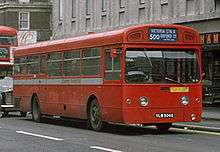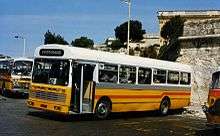AEC Swift
The AEC Swift was a rear-engined step entrance single-decker bus chassis manufactured by AEC between 1964 and 1980.[1] The chassis design was closely related to the Leyland Panther. It was available in 33' and 36' lengths, with an AEC AH505 or AH691 engine.[2]
| AEC Swift | |
|---|---|
_bus_SMW9_(XCY_467J)_1971_AEC_Swift_Marshall%2C_St_Albans%2C_May_1976.jpg) | |
| Overview | |
| Manufacturer | AEC |
| Production | 1964–1980 |
| Body and chassis | |
| Doors | 1 or 2 |
| Floor type | Step entrance |
| Related | Leyland Panther |
| Powertrain | |
| Engine | AEC AH505 AEC AH691 AEC AH760 |
| Capacity | 9.6 litres 11.3 litres 12.4 litres |
| Dimensions | |
| Length | various |
| Width | 2.5m |
| Height | 3.0m |
The design was suitable for driver-only operation which helped bus operators to relieve the problems of labour shortages and costs, and became one of the alternatives to the British double-decker buses which could only be operated by a driver and conductor, such as the London AEC Routemaster or Bristol Lodekka), as British legislation prevented driver-only operation of double-decker buses until the late 1960s.
London
_1971_AEC_Swift_Park_Royal%2C_Golders_Green%2C_route_240A%2C_April_1978.jpg)

The largest fleet was operated by London Transport and London Country Bus Services, with over 1,500 in total delivered between 1966 and 1972. Bodywork was supplied by Strachans Coachwork (prototypes only), Park Royal Vehicles, Metro Cammell Weymann and Marshall, to basically the same design.
The fleet was made up of a number of variations. The Longer 36' versions were referred to as Merlins, and divided into MB (single or dual door), MBS (dual door), and MBA (dual door with turnstile payment for use on Red Arrow services) classes.
The shorter 33' versions were known as Swifts. There were three variants of this model upon delivery. In the central area SM (single door saloon) and SMS (dual door with automatic fare collection) classes were painted red. London Country operated green SM-class dual door, fully seated saloons that had been ordered by London Transport. Subsequently, London Transport converted a number of SMS vehicles to conventional one-man operated saloons by adding more seats and locking the centre exit out of use. These were renamed the SMD class, but retained their original fleet number.
Neither London Transport nor London Country considered either design to be a success and the first examples were withdrawn and sold, many for scrap, in 1972, after just four years service.[3] Most had been replaced by 1981 mainly by Leyland Nationals and MCW Metrobuses.[4]
Some were taken by the Malta Department of Education and remained in their London form apart from a new coat of paint.
Other operators in the UK
AEC Swifts were also sold to several other operators. Over 100 were sold to Leeds City Transport, transferring to West Yorkshire PTE on its formation in 1974. Aberdeen Corporation Transport, Birmingham City Transport and Sunderland Corporation took smaller numbers of Swifts.[5][6][7][8]
Great Yarmouth Transport bought eight Swifts new in 1973; the last of 22 purchased new and three secondhand; they continued in service until the late 1990s, and were the last Swifts to run in service with their original operator.[9] Other customers included Blackpool Transport with 55 examples and St Helens Corporation.[10][11] Three Swifts delivered to Morecambe Corporation in 1970 carried rare Northern Counties bodywork.[12]
Following withdrawal from service with their initial operators, many Swifts were sold on for further use. Staffordshire-based independent Knotty Bus ran a fleet of four Swifts between 1988 and 1995.[10] A small number of former London Transport Swifts ran for a time with Hants & Sussex (now Emsworth & District) on services in south east Hampshire.[13]
British Airways once owned an AEC Swift, with a special body that had an open platform at the front, which was designed for airside duties. Citybus, Belfast purchased 177 Swifts and Merlins between 1977 and 1980 to replace buses destroyed during the Troubles, although most were withdrawn after 1981.[14]
Exports

AEC Swifts were also sold for the export market, and many were sold abroad after withdrawal. Sixty-five Swifts with bodywork by local builder Bus Bodies were sold to South African operator Durban Transport in 1974.[15]
Australian Capital Territory operator ACTION purchased 101 AH505 powered Swifts between 1967 and 1975.[16] The State Transport Authority of Adelaide, purchased 292 AH691 powered Swifts in 1970-72 followed by 66 AH760 examples in 1978.[17][18] In 1980/81, twelve AH760 Swifts were bodied by Domino, Pressed Metal Corporation and Pressed Metal Corporation South Australia for Deanes Coaches and West Bankstown Bus Service in Sydney.[19][20][21]
Approximately 50 former London Transport Merlins were exported for further use in Australia.[22] Several former London Transport vehicles were sold to Malta bus where after refurbishment and repowering they remained in service until 2011.[23] In early 1981, ten Swifts recently withdrawn by London Transport were exported to Italy to act as emergency control centres and shelters in the aftermath of the 1980 Irpinia earthquake.[24]
References
- Millar, Alan (1992) Bus & Coach Recognition : Ian Allan Publishing, ISBN 0-7110-2060-4
- AEC Swift 691 / PRV single-deck bus Commercial Motor 2 August 1968
- Gone for a song LTMerlins Commercial Motor 4 February 1977
- The London Transport Merlins and Swifts Ian's Bus Stop
- Millar, Alan (1988). "Blunderbus". In Brown, Stewart J. (ed.). Buses Yearbook 1989. Ian Allan Publishing. p. 11. ISBN 0-7110-1785-9.
- Swifts for Aberdeen Commercial Motor 9 August 1968
- AEC standee bus fleet for Birmingham Commercial Motor 6 October 1967
- AEC Swifts for Sunderland Commercial Motor 23 December 1966
- Brown, Stewart J. Buses in Britain 2: The Mid Nineties. p. 142. ISBN 1-85414-181-3.
- Brown (1995) p.120
- St Helens Commercial Motor 15 March 1968
- Townsin, Alan (1998). AEC. Ian Allan Publishing. p. 126. ISBN 0-7110-2620-3.
- Brown (1995) p.175
- Millar, G. Irvine (December 2009). "The man who made Ulsterbus". Buses. Ian Allan Publishing (657): 16–18.
- Townsin, Alan (1980). Blue Triangle. Transport Publishing Company. p. 221. ISBN 0-903839-34-2.
- Disposal List ACT Bus Wiki
- Travers, Greg (1989). The Australian Government Bus. Elizabeth, South Australia: Railmac Publications. p. 13. ISBN 0-949817-75-9.
- Admet Disposal Lists Australian Bus Fleet Lists
- Shorelink Australian Bus Fleet Lists
- Bankstown Strathfield Bus Service Australian Bus Fleet Lists
- West Bankstown Bus Service Australian Bus Fleet Lists
- AEC Merlins in Australia Australian Bus Fleet Lists
- Johnson, Tom (February 2004). "Malta goes modern". Buses. Ian Allan Publishing (587): 34–37.
- Morris, Stephen (February 1981). "Swift aid for Italy". Buses. Ian Allan Publishing (311): 69.
External links

- Showbus gallery
- Flickr gallery
- Bus Australia Merlin gallery
- Bus Australia Swift gallery